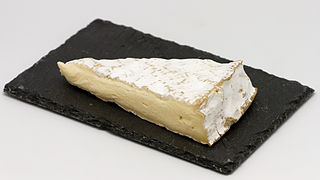
Brillat-Savarin is a soft-ripened triple cream cow's milk cheese with at least 72% fat in dry matter. It has a natural, bloomy rind. It was created c. 1890 as "Excelsior" or "Délice des gourmets" by the Dubuc family, near Forges-les-Eaux in Seine-Maritime. Brillat-Savarin is produced all year round mainly in Burgundy.

Halloumi or haloumi is a cheese that originated in Cyprus. It is made from a mixture of goat's and sheep's milk, and sometimes also cow's milk. Its texture is described as squeaky. It has a high melting point and so can easily be fried or grilled, a property that makes it a popular meat substitute. Rennet is used to curdle the milk in halloumi production, although no acid-producing bacteria are used in its preparation.

Munster, Munster-géromé, or (Alsatian) Minschterkaas, is a soft cheese with a strong taste and aroma, made mainly from milk first produced in the Vosges, between the Alsace-Lorraine and Franche-Comté regions in France. The name "Munster" is derived from the Alsace town of Munster, where, among Vosgian abbeys and monasteries, the cheese was conserved and matured in monks' cellars.

Brie de Meaux is a French brie cheese of the Brie region and a designated AOC product since 1980. Its name comes from the town of Meaux in the Brie region. As of 2003, 6,774 tonnes were produced annually.

Cantal cheese is an uncooked firm cheese produced in the Auvergne region of central France: more particularly in the département of Cantal as well as in certain adjoining districts. Cantal cheese was granted Appellation d'Origine Contrôlée certification in 1956. One of the oldest cheeses in France, Cantal dates back to the times of the Gauls. It came to prominence when Marshal Henri de La Ferté-Senneterre served it at the table of Louis XIV of France. Senneterre is also responsible for the introduction of Saint-Nectaire and Salers.

Beaufort is a firm, raw cow's milk cheese associated with the gruyère family. An Alpine cheese, it is produced in Beaufortain, Tarentaise valley and Maurienne, which are located in the Savoie region of the French Alps.

Saint-Nectaire is a French cheese made in the Auvergne region of central France.
Caș is a type of semi-soft white fresh cheese produced in Romania. It is made by curdling sheep or cow milk with rennet, and draining the whey. The resulting cheese is unsalted or lightly salted. If stored in brine, caș turns into Telemea after 2–3 weeks.

Langres is a French cheese from the plateau of Langres in the region of Champagne-Ardenne. It has benefited from an Appellation d'origine contrôlée (AOC) since 1991.

Mimolette is a cheese traditionally produced around the city of Lille, France. In France it is also known as Boule de Lille after its city of origin, or vieux Hollande because it was originally inspired by the Dutch Edam cheese.

Gaperon is a French cheese of the Auvergne region. The Gaperon has been produced for over 1200 years in Auvergne.

Chabichou is a traditional semi-soft, unpasteurized, natural-rind French goat cheese with a firm and creamy texture. Chabichou is formed in a cylindrical shape which is called a "bonde", per the shape of the bunghole of a wine barrel. and is aged for 10 to 20 days. It is the only goat cheese that is soft ripened allowed by Protected Designation of Origin regulations to be produced using pasteurized milk. Chabichou is very white and smooth, and flexible to the palate, with a fine caprine odor.

Fourme de Montbrison is a cow's-milk cheese made in the regions of Rhône-Alpes and Auvergne in southern France. It derives its name from the town of Montbrison in the Loire department.

Brânză de burduf is a salty type of Romanian cheese, made with sheep milk. It has a strong flavour and slightly soft in texture.
Lighvan is a sour, hole filled brined curd cheese traditionally made from sheep's milk in Liqvan, a village in East Azerbaijan, Iran.

There are several regional types of Serbian cheeses, such as the Sjenica, Zlatar, Svrljig and Homolje cheeses. The Pule cheese has gained much notoriety since 2000s as it became the most expensive cheese in the world.
















